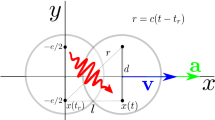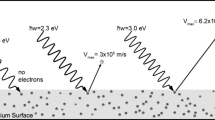Abstract
A previous paper was devoted to the discussion of a new version of stochastic electrodynamics (SED) and to the study of the conditions under which quantum mechanics can be derived from it, in the radiationless approximation. In this paper further effects on matter due to the zeropoint field are studied, such as atomic stability, radiative transitions, the Lamb shift, etc., and are shown to be correctly described by the proposed version of SED. Also, a detailed energy-balance condition and a fluctuation-dissipation relation are established; it is shown in particular that equilibrium is attained only with a field spectrum ∼Ω 3.The proposed approach is shown to suggest an understanding of quantum mechanics as a kind of limitcycle theory. Finally, a brief discussion is included about the nonchaotic behavior of the (bounded) SED system in the quantum regime, as measured by Lyapunov exponents.
Similar content being viewed by others
References
L. de la Peña and A. M. Cetto, “Quantum phenomena and the zeropoint radiation field,”Found. Phys. 24, 917 (1994).
See, e. g., L. E. Reichl,A Modernm Course in Statical Physics (University of Texas Press, Austin, 1980).
L. de la Peña and A. M. Cetto,Nuovo Cimento B 92, 189 (1986).
L. de la Peña, inStochastic Processes Applied to Physics and Other Related Fields, B. Gómezet al. eds. (World Scientific, Singapore, 1983).
T. W. Marshall and P. Claverie,J. Math. Phys. 21, 1819 (1980); P. Claverie, L. Pesquera, and F. Soto,Phys. Lett. A 80, 113 (1980); P. Claverie and F. Soto,J. Math. Phys. 23, 753 (1982); L. Pesquera, thesis, Université de Paris VI, 1980, unpublished.
A. M. Cetto and L. de la Peña, inNonlinear Fields: Classical, Random, Semiclassical, P. Garbaczewski and Z. Popowicz, eds. (World Scientific, Singapore, 1991), pp. 416, 436.
M. Alcubierre and N. S. Lozano,Tratamiento de sistemas multiperiódicos en la electrodinámica estocástica, thesis, UNAM, 1988, unpublished.
T. W. Marshall,Proc. Cambridge Philos. Soc. 61, 537 (1965); T. H. Boyer,Phys. Rev. 182, 1374 (1969).
D. C. Cole,Phys. Rev. A 42, 1847 (1990),Phys. Rev. A 45, 8471 (1992).
J. H. van Vleck and D. L. Huber,Rev. Mod. Phys. 49, 939 (1977).
T. H. Boyer,Phys. Rev. D 13, 2832 (1976);Phys. Rev. A 18, 1228 (1978).
R. Blanco, L. Pesquera, and E. Santos,Phys. Rev. D 27, 1254 (1983);29, 2240 (1984); E. Santos, inStochastic Processes Applied to Physics, L. Pesquera and M. A. Rodríguez, eds. (World Scientific, Singapore, 1985).
A. M. Cetto and L. de la Peña,Phys. Rev. A 37, 1952, 1960 (1988);Phys. Scr. T 21, 27 (1988). See also L. de la Peña and A. M. Cetto,Found. Phys. 19, 419 (1989).
H. B. Callen and T. A. Welton,Phys. Rev. 83, 34 (1951). See also, e.g., Ref. 2, Chap. 15.
For a comparison with similar results of nonrelativistic SED for a two-level atom, see P. W. Milonni,Phys. Scr. T 21, 102 (1988).
See, e.g., D. J. Kaup,Phys. Rev. 152, 1130 (1966).
A. M. Cetto and L. de la Peña,Rev. Mex. Fis. 29, 537 (1983). Causal versions of radiation reaction are well known; a nice discussion can be found in the book cited in Ref. 20.
The form factorK(Ωs 0) coincides with that derived in D. Bohm and M. Weinstein,Phys. Rev. 74, 1789 (1948).
An early derivation of theA coefficient for the SED harmonic oscillator can be found in T. W. Marshall,Izv. Vyssh. Uchebn. Zaved., Fiz. 11, 34 (1968); more recent results can be seen in L. de la Peña and A. M. Cetto,J. Math. Phys. 20, 469 (1979); H. M. FranÇa, T. W. MarshallPhys. Rev. A 38, 3258 (1988); H. M. FranÇa, T. W. Marshall and E. Santos,Phys. Rev. A 45, 6436 (1992).
P. W. Milonni,Phys. Rep. 25, 1, 1 (1976) and references therein. See also P. W. Milonni,The Quantum Vacuum (Academic, San Diego, 1994).
T. A. Welton,Phys. Rev. 74, 1157 (1948).
H. A. Bethe,Phys. Rev. 72, 339 (1947); reprinted inQuantum Electrodynamics, J. Schwinger, ed. (Dover, New York, 1958). J. J. Sakurai,Advanced Quantum Mechanics (Addison-Wesley, Reading. Massachusetts, 1967).
L. de la Peña and A. M. Cetto,Found. Phys. 8, 191 (1978), L. de la Peña and A. Jáuregui,Found. Phys. 12, 441 (1982). See also the second paper cited in Ref. 19.
E. Santos,Nuovo Cimento B 19, 57 (1974). See also L. de la Peña and A. M. Cetto, inProceedings, International Symposium on the Foundations of Quantum Physics, Oviedo 1993. M. Ferrero and A. van der Merwe, eds. (Kluwer Academic Press, San Diego, 1995).
S. Eubank and D. Farmer, in1989 Lectures in Complex Systems (Lecture Vol. II); E. Jen, ed. (Addison-Wesley, Reading, Massachusetts, 1990).
J. P. Eckmann and D. Ruelle,Rev. Mod. Phys. 57, 617 (1985).
M. Hossein Partovi,Phys. Rev. A 45, R555 (1992).
R. L. Ingraham, M. E. Goggin, and P. W. Milonni, inCoherence and Quantum Optics VI J. H. Eberlyet al. eds. (Plenum, New York, 1990).
Author information
Authors and Affiliations
Additional information
On Leave of absence at Mathematics Department, University College London, srGower Street, London WC1, United Kingdom.
Rights and permissions
About this article
Cite this article
de la Peña, L., Cetto, A.M. Quantum phenomena and the zeropoint radiation field. II. Found Phys 25, 573–604 (1995). https://doi.org/10.1007/BF02059007
Received:
Issue Date:
DOI: https://doi.org/10.1007/BF02059007




